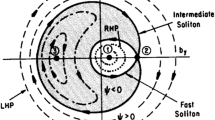Abstract
In a driven/damped drift-wave system a steady wave induces nonlinear variation of the dispersion of a perturbation wave (PW). Competition between the nonlinear dispersion with self-nonlinearity of the PW results in rich wave dynamic behaviors. In particular, a steady wave at the negative tangency slope of a hysteresis becomes unstable due to a saddle instability. It is found that such saddle steady wave (SSW) plays an important role in the discontinuous transition from a spatially coherent state to spatiotemporal chaos (STC). The transition is caused by a crisis due to a collision of the PW attactor to an unstable orbit of the SSW. In the time evolution, it is a ‘pattern resonance’ of the realized wave with the virtual SSW that triggers the crisis. The transition also displays as a critical phenomenon in parameter space, which is related to the change in the symmetry property of the motion of master mode (k = 1) of the PW with respect to that of SSW. In the spatially coherent state the former is trapped by the SSW partial wave, while in the STC it can become free from the latter, its trajectory crosses two unstable orbits of the SSW frequently, causing very turbulent behavior.
Similar content being viewed by others
References
Ott, E.: 1993, Chaos in Dynamic Systems, Cambridge, New York.
Cross, M. C. and Hohenberg, P. C.: 1993, Rev.Mod.Phys. 65851.
Sagdeev, R. Z. et al.: 1988, Nonlinear Physics From the Pendulum to Turbulence and Chaos, Harwood Academic Publishers, London, Chapter 11.
Lichtenberg, A. and Lieberman,: 1983, Regular and Stochastic Motion, Springer, New York. Biskamp, D. and He, K.: 1985, Phys.Fluids 282172.
Klinger, T., Latten, A., Piel, A., Bonhomme, G., Pierre, T. and de Wit, T. D.: 1997, Phys.Rev.Lett. 79, 3913.
Biskamp, A. R. et al.: 1983, Phys.Rev.Lett. 501095.
Gregobi, C. et al.: 1982, Phys.Rev.Lett. 481507.
Oraevskii, V., Tasso, H. and Wobig, H.: 1969, Proc.3rd Inter.Conf.on Plasma Physics and Controlled Nuclear Fusion Research, Novosibirsk, IAEA, Vienna, Vol. I 67.
Dodd, R. K. et al.: 1982, Solitons and Nonlinear Wave Equations, Academic Press, London. Chen, W. and Mills, D. L.: 1987, Phys.Rev.Lett. 58160.
He, K. and Salat, A.: 1989, Plasma Phys.Contr.Fusion 31123.
He, K.: 1992, Phys.Lett. A169, 341.
He, K.: 1994, Phys.Lett. A190, 38.
He, K.: 1995, Phys.Lett. A202, 369.
He, K. and Zhou, L.: 1997, Phys.Lett. A231, 65.
He, K.: 1998, Phys.Rev.Lett. 80, 696.
He, K.: 1999, Phys.Lett.E 59, 5278.
He, K.: 2000, Phys.Rev.Lett. 84, 3290.
He, K.: 2001, Phys.Rev.E. 63, 016218.
Author information
Authors and Affiliations
Rights and permissions
About this article
Cite this article
He, K. Critical phenomenon, crisis and transition to spatiotemporal chaos in plasmas. Space Science Reviews 107, 475–494 (2003). https://doi.org/10.1023/A:1025558108473
Issue Date:
DOI: https://doi.org/10.1023/A:1025558108473




